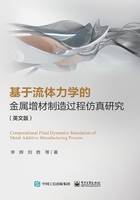
3.2 Simulation model of L-PBF printer
3.2.1 Geometry of L-PBF printer with a fluid stabilizing cover
Fig. 3-1 shows the geometric model of the L-PBF printer with a fluid stabilizing cover (red part). The printer design was self-developed based on the structure of BLT-S310. The size of the printer's main cavity is 440 × 782 × 483 mm3,the size of the workbench is 255 × 255 mm2,the height of the gas inlet 1 is 30 mm,the length is 300 mm,the distance of the gas inlet 2 from the workbench is 388 mm,and the diameter of the inlet pipe and the outlet pipe are 72 mm. Three scanning paths are set on the workbench to simulate the discharge of sputtered particles at different positions on the workbench.
3.2.2 Numerical model of printer with a fluid stabilizing cover
In the study,the shielding gas flow was assumed to be incompressible,transient and turbulent flow. Reynolds-averaged Navier-Stokes equations and standard k-ε turbulent model was used to describe the fluid characteristics [4]. The main governing equations could be described as follows [5]:
Continuity equation

where ρ is the density of fluid and ![]() is the average velocity.
is the average velocity.
Momentum equation

where p is the static pressure,τ is the stress tensor,![]() and
and ![]() are external body forces and the gravitational body force,respectively.
are external body forces and the gravitational body force,respectively.

Fig. 3-1 Geometric model of L-PBF printer with fluid stabilizing cover (red part)
The pressure-velocity coupling analysis was achieved by utilizing the SIMPLE scheme,and the solution in each time step was considered to be converged since all residuals had reached 1 × 10-3.
The materials of shielding gas,chamber walls and particles are Argon,Aluminium and Ti-6Al-4V,respectively. The physical properties of the materials are listed in Table 3-1. The gravitational acceleration (g) was assumed to be 9.8 m/s2 along the Z-direction. The environmental pressure was set as 1.01325 × 105 Pa,the environmental temperature was 300 K,and inlet velocity of argon flow was 4 m/s.
Table 3-1 Material properties

3.2.3 Mesh of L-PBF printer with a fluid stabilizing cover
Considering the complex structure of the printer,both structured grid and unstructured grid are used to generate the mesh. Fig. 3-2 shows the mesh of L-PBF printer with a fluid stabilizing cover inside,whose total number of elements is 4577136.In order to more accurately simulate the flow field above the workbench,the number of grids in the area from 0 to 58 mm from the workbench surface has been increased. In addition,boundary layer with 5 inflation layers was applied to pipe boundaries.

Fig. 3-2 The mesh of L-PBF printer with a fluid stabilizing cover inside
3.2.4 Model of the fluid stabilizing cover and particles
During the printing process,particles will be sputtered from the workbench under the action of high-energy laser. A discrete phase model (DPM) was developed to simulate the phenomenon.
Fig. 3-3 shows the model of fluid stabilizing cover,including the position of the fluid stabilizing cover relative to the printer cavity,as well as the geometry and size of the fluid stabilizing cover itself. The height of the fluid stabilizing cover is 200 mm,and the distance from the workbench is 58 mm. The two sides of the fluid stabilizing cover are connected with the printer cavity. There is a proper gap between the fluid stabilizing cover and the printer cavity,which will not interfere with the operation of the internal mechanical structure of the printer.

Fig. 3-3 The model of fluid stabilizing cover

Fig. 3-3 The model of fluid stabilizing cover(successive)
Fig. 3-4 shows the release of particles,including the direction of the sputtered particles and the position of the particles. In the actual printing process,sputtering particles may be generated on the entire work surface. In order to simulate the adsorption of particles more realistically,three laser scanning points moving along the X axis are set on the workbench to release particles at the same time. The moving speed of the laser is 0.5 m/s,and the scanning time is 0.5 s. The number of particles released per second in each direction is 1000,and a total of 4500 particles are released during the entire scanning process. The initial velocity of sputtered particles is a variable will be researched later.

Fig. 3-4 The release of particles
To efficiently simulate the flow-particle interaction,some assumptions were made as follows:
(1) The particles are dilute and the interactions between particles are negligible.
(2) One-way coupling between the continuous phase and discrete phase(particles).
(3) The particles are spherical and the diameter was 50 μm[6].
(4) Spatter particles were assumed to be ejected along the nine directions (0~8)showed in Fig. 3-4.
(5) The frequency of generating particle in each direction was set as 1000 per second,and 4500 particles were ejected totally.
(6) The adsorption situation of three kinds of particles with different initial velocities on the workbench is simulated respectively. The initial particle velocity is set to 3 m/s,5 m/s,and 7 m/s.
Three types of DPM settings were applied to different wall surfaces: the powder bed and bottom plane of the chamber were set as ‘trap' boundaries. Other wall surfaces such as fluid stabilizing cover wall were set as ‘reflect' boundaries. In addition,the outlet was set as ‘escape' boundary condition,particles will be cleared from the computational domain after moving through the boundary.